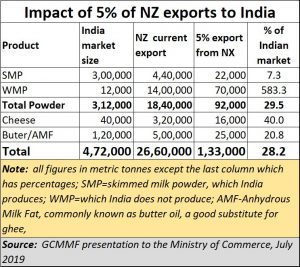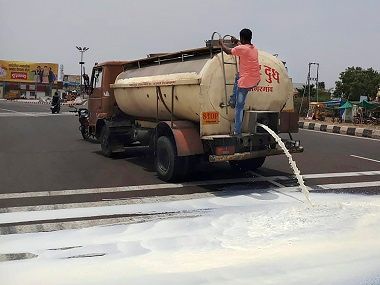https://www.freepressjournal.in/editorspick/indias-interests-in-milk-almost-sold-away-to-new-zealand
India’s milk interests sought to be sabotaged by bureaucrats
RN Bhaskar – 15 Aug 2019
Milk is one of the most strategically important industries for India. It is one which has spawned Asia’s largest agricultural brand in Amul. It has witnessed year-on-year growth to become the world’s largest producer of milk. Today, the dairy industry accounts for 25% (Rs 7 lakh crore) of total farm produce of the country (estimated at Rs 28 lakh crore). It is also the shortest way to rural prosperity for any farmer who has cattle in his backyard (More details on this industry can be got from https://www.freepressjournal.in/india/significance-of-the-dairy-industry).
 All this was possible because of the vision of Dr. Verghese Kurien who ensured that the Indian farmer gets paid more for his milk than anywhere in the world. His reasoning was simple. If a farmer gets paid more, he will produce more. At the same time consumers were also protected, by paying the lowest milk prices in the world. As a result, farmers got anywhere between 70-86% of the milk market price. Kurien’s strategies ensured that all procurement, processing, marketing and distribution were managed within 20-30% of the money left over. That guaranteed increased milk production, and demand. Per capita consumption soared from 110 grammes per day in 1973 to 369 grammes in 1918. All this made the farmer richer, the consumer healthier (on account of better nutrition) and the country wealthier.
All this was possible because of the vision of Dr. Verghese Kurien who ensured that the Indian farmer gets paid more for his milk than anywhere in the world. His reasoning was simple. If a farmer gets paid more, he will produce more. At the same time consumers were also protected, by paying the lowest milk prices in the world. As a result, farmers got anywhere between 70-86% of the milk market price. Kurien’s strategies ensured that all procurement, processing, marketing and distribution were managed within 20-30% of the money left over. That guaranteed increased milk production, and demand. Per capita consumption soared from 110 grammes per day in 1973 to 369 grammes in 1918. All this made the farmer richer, the consumer healthier (on account of better nutrition) and the country wealthier.
Obviously, therefore, one expects India’s negotiators to be better informed. Yet this time – at the on-going Regional Comprehensive Economic Partnership (RCEP) and Free Trade (FTA) agreement discussions in Beijing, China — India’s officials forgot all this. They almost sold away India’s strategic strengths for virtually nothing to New Zealand (NZ).
NZ is a major milk producing country, and has been one of the most aggressive milk exporters partly on account of its large production and also because of its scant population. Hence, almost 93% of NZ’s milk production gets exported, while much of India’s milk gets consumed domestically, with little getting exported.
But that is changing. India’s milk industry is growing rapidly and is likely to reach 330 million tonnes by 2033. Deduct the estimated domestic milk demand of 292 million tonnes and you get a surplus of 38 million tonnes a year. Obviously, India’s export capabilities are growing. That is another reason why milk is of immense strategic significance for India.
That explains why the proposals made by NZ, and tentatively accepted by India’s officials, were worryingly baffling. Fortunately, the agreements mean nothing till approved by Parliament. But it does point to the utter lack of understanding of India’s strategic strengths and a willingness to sell out to glib, seductive and ruthless global players. What action the government takes against its officials for this criminal incompetence is something best decided by the authorities. But the milk industry is understandably livid.
Experts point to how the NZ proposals appear innocuous but are lethal in their impact. The Indian officials see little harm in allowing NZ export up to 5% of their total value-added milk products, but not liquid milk. They thought that such small quantities would not hurt India’s core interests of liquid milk. But the numbers tell another story (see table).
First, in the milk industry, liquid milk is only the starting point. There are lean and flush seasons. When there is more milk produced, the industry converts the surplus into powder which is then reconstituted ito milk during lean periods.
Second, when the total milk of both lean and flush seasons becomes larger than total demand, the surplus is converted into value-added products. This gives perishable milk a longer shelf life, and the produce is sold at higher prices.
Third, not being able to make and sell value-added milk products will cause surplus milk to be thrown away. That will mean losses, which will mean lower payouts to the farmers. It will persuade farmers to produce less milk. That, in turn, will hurt India’s self-sufficiency and make it import dependent once again.
The NZ proposals could make India lose 28% of its market, totalling Rs.3.5 lakh crore a year. It could also destroy the prime minister’s resolve of doubling farm incomes. It will cripple the Indian milk industry in much the same way India’s edible oil industry was allowed to wither (http://www.asiaconverge.com/2017/09/absurd-posturing-anti-gm-lobby/).
In a hard hitting presentation to the ministry (it can be downloaded from http://www.asiaconverge.com/wp-content/uploads/2019/08/2019-07-22_GCMMF-Presentation-to-Minister-and-Additional-Secretary-Commerce-Ministry-Mumbai-22nd-July-2019.pdf), the industry has pointed out how dangerous the NZ proposals are. The ministry has now woken up and has promised to look into the negotiations once again.
But why did this happen? Are India’s bureaucrats so gullible? Are they so criminally lethargic that they did not even do their homework? Answers are needed urgently. This must never happen again.





































COMMENTS